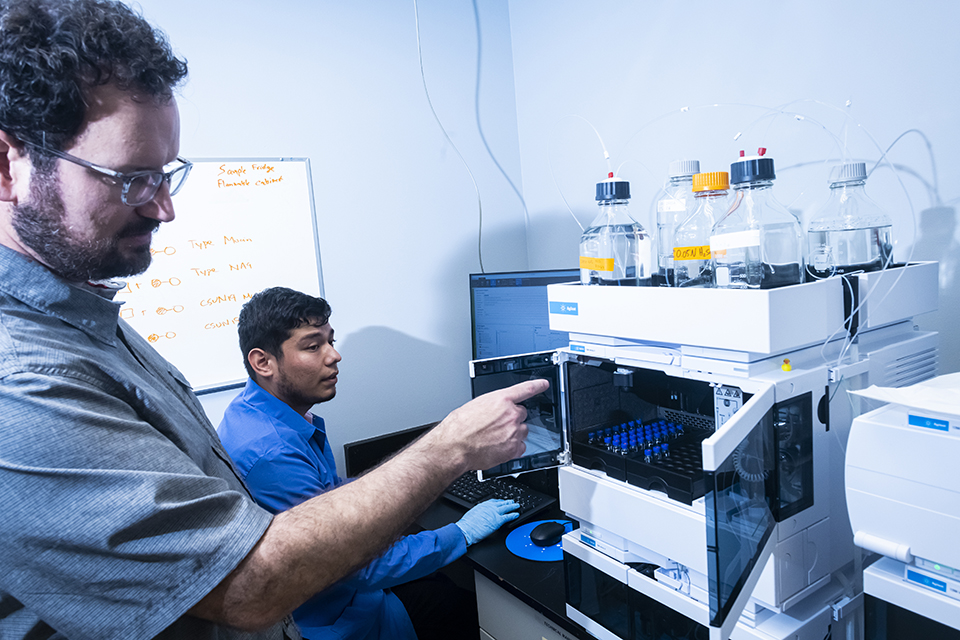Gut Bacteria Research Grows with New Equipment in CSUN Microbiology Lab

CSUN Professor Gilberto Flores and graduate student Luis Duran work with a High-Performance Liquid Chromatography system (HPLC), which arrived at CSUN in May. Photo by David J. Hawkins
Luis Duran ’23 (Biology) spent this summer, before he started his master’s program at California State University, Northridge, learning how to use a new, high-tech machine that measures the byproducts of bacterial growth.
Now he’ll be able to teach other students to use the machine, a High-Performance Liquid Chromatography system (HPLC), which arrived at CSUN in May. It’s part of a series of high-tech upgrades in professor Gilberto Flores’ microbiology lab, where the professor and students research the bacterial community called the human gut microbiome — and how these communities contribute to human health.
The HPLC and other upgrades will have a massive impact on the research opportunities related to microbial physiology available to students and faculty.
“Being able to understand how the machine works and understand what we’re getting out of it, and what the results mean for us, I think that helps a lot,” Duran said. “It’s a great addition to the lab, and is going to help us move forward in several projects that we have.”
The HPLC was one of two new cutting-edge pieces of equipment made possible by a $250,000 anonymous donation to the laboratory of professor Flores in the Department of Biology in the College of Science and Mathematics, which was matched by the CSUN Foundation as part of its 2022 Matador Match Challenge initiative — totaling $500,000 for lab enhancements.
“It expands our capabilities of what we can do,” said Flores, a microbial ecologist. “It should also be able to accelerate our research, and expand the type of studies that we can do. It should open new avenues of getting grant funding, enabling us to attract more research dollars, and hopefully enabling us to attract more students.”
The work Flores and his students do have applications for probiotics, including treatments for Type 2 diabetes and obesity. The new lab capabilities will help students develop marketable skills for the biotech industry.
Microbes in the large intestine help digest fibers from foodstuffs, a process called fermentation. The HPLC can measure the byproducts of fermentation in a culture of bacteria, such as fatty acids. These are waste products for the bacteria, but some can be absorbed by the human body for beneficial purposes, including energy.
Before the HPLC was installed, Flores had to outsource measurements of these byproducts, adding time and money to the research process.
A second piece of equipment made possible by the gift, which will be installed later this year, is an anaerobic bioreactor. Without the bioreactor, Flores and other researchers can only study bacteria inside a test tube, which is a closed system — once the culture is in the tube, the bacteria can run out of food or the waste products of growth eventually inhibit growth or kill the bacteria — for example, at a certain point, production of too much fatty acids acidify the culture medium and inhibit further bacterial growth.

Postdoctoral researcher Ashwana Fricker. transfers a bacterial culture in an anaerobic glove box. Photo by David J. Hawkins
The bioreactor will be used to study an organism or a mixture of organisms in a continuous way, so there’s new food coming in and waste coming out. The bioreactor helps modulate the environment so the bacterium or community can sustain itself. For example, if a culture is getting too acidic, the bioreactor can help balance the pH levels.
The bioreactor isn’t a perfect analog for a live human gut, but it makes for a more realistic environment to study the complexities of bacterial growth.
The new equipment enables Flores and his students to combine traditional microbiology — growing an organism to understand what it eats and what waste it produces — with more recent techniques of examining communities of microbes with DNA and RNA sequencing.
The two machines can also work together.
“The products that are being made in real-time in the bioreactor, we can measure some of those with the HPLC that is right there next to it,” Flores said. “Having both of those in-house now is pretty important, and at the cutting edge of the science.”
The gift is already having a significant impact on student learning, Duran said.
His goal is to be a middle school science teacher, but he is enjoying his research and said he could consider switching to a more research-focused career.
“It’s been a fantastic experience,” Duran said. “I’ve been learning a lot.”

 experience
experience